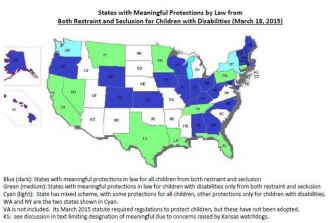Back in 2010, the House of Representatives passed a bill regulating the use of restraint and seclusion in schools, but it never passed the Senate. However, states are using the language from what was titled the “Keeping All Students Safe Act” to craft their own restrictions on the discipline methods, according to a report compiled by a disability-rights advocate.
Jessica Butler, the congressional affairs coordinator for the Autism National Committee, has been tracking the issue since 2009. In 2012, she started publishing her findings in a report, “How Safe is the Schoolhouse? An Analysis of State Seclusion and Restraint Laws and Policies.” Her latest effort was released this week.
When Butler started her work in 2009, nine states had what she deemed “meaningful” laws restricting the use of restraint and seclusion with all students, and 21 had such policies in place specifically for students with disabilities, who are far more likely to be restrained and secluded than their typically developing peers.
As of this report, 22 states have such protections for all students, and 34 provide such protections for students with disabilities. Butler uses “meaningful” to describe states with laws (as opposed to non-binding guidance) that prohibit the use of restraint and seclusion except to prevent injury to the student or others, or states that offer multiple protections against restraint and seclusion.
This map, taken directly from the report, shows in dark blue the states that have regulations on restraint and seclusion that apply to all students. The states depicted in green have regulations in place for students with disabilities. Virginia, which just this month passed a law restricting the use of restraint and seclusion, does not yet have regulations in place, which is why Butler chose not to include it yet in her report.

Washington and New York, shown here in light blue, have different restrictions in place for students with disabilities compared to their peers in general education.
Though more states are passing laws regulating restraint and seclusion, there’s still a lack of uniformity, Butler said. For example, Arkansas prohibits seclusion but not restraint. Delaware bans seclusion and restraint, but allows the state to waive those bans on a student-by-student basis based on “compelling justification.” And not all states require that parents be notified when their children have been restrained or secluded in school.
These policies should not change when a student crosses state lines, Butler said. “A child living in Philadelphia, whose parents make the decision to move to the New Jersey suburbs, should not lose their protection. There’s definitely a need for a national bill that has these protections built in.”
And a national bill does still exist. Rep. Don Beyer, a Democrat from Virginia, introduced as his first piece of legislation after his election a revival of the Keeping All Students Safe Act.
Related stories:
